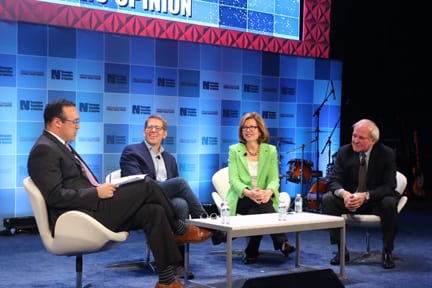 Watch: Full Session Video (member log-in required)
Watch: Full Session Video (member log-in required)
When Michael McCurry worked as White House Press Secretary, he said social media was taking the reporters out for drinks.
A few terms later, it was a different world for Jeff Carney who served as White House Press Secretary for President Obama from 2008 to 2014. It was the first digital savvy White House.
At mediaXchange 2016, Carney and McCurry were joined by Susan Page, Washington Bureau Chief of USA TODAY in the session “Covering the White House,” moderated by Chris Cillizza, Political Reporter of The Washington Post.
In the time between McCurry’s White House and Carney’s White House, it became a world where the President was talking to YouTube stars and appearing in Buzzfeed articles instead of traditional news formats. Press conferences blindsided the staff with minute-by-minute Twitter updates and the news cycle turned over in minutes. Carney said the hardest interview for President Obama was with Jon Stewart on late-night TV.
“The President of the United States could give a speech in the middle of the day and 95 percent of Americans would miss it, and it could be an important speech,” Carney said.
He says the biggest trick is learning what matters and what doesn’t, in real time.
For Page, this constant news cycle means continuous reporting, having to be faster at telling a story, telling it differently and applying context to it all at the same time.
“You do that all day, instantly,” she said.
In the days before social media, it was one story line, one narrative per day.
“It would be one White House was trying to get out in front of the public or one the media decided was more important,” McCurry said. “Maybe there are more messages that the American public needs to absorb.”
When McCurry became White House Press Secretary, he says the press meetings were not broadcast. He changed that.
“It was a mistake,” he said. “I allowed the thing to be televised, then the Monica thing in ‘98 made it a substitute for daytime soap operas.”
Now the press meetings are competitive, aggressive and full of “gotcha” questions.
At the conference, the Press Secretaries and the reporters were at odds about access. Should the White House tweet out photos that journalists were not able to have access to?
Carney says it would be malpractice for a White House to have access to social media and technology and not take advantage of it. Page rebutted that the White House was denying opportunity.
“The issue is, do you let news photographers into events that they’ve typically been able to photograph because they’re journalists too,” she said.
McCurry suggests there might be a balance. He wants to see a change from the competition and trying to get the scoop.
“Do not worry about scoop and speed,” he said. “Speed needs to be replaced with substance and depth.”
